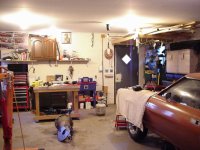Is there such a thing as an 'in slab' temperature probe that gives feedback to the thermostat based on the slab temp rather than the air temp?? Or is that a stupid idea because the main goal is warm air, not a warm slab??
-Jer.
YES
In that electric floor heating calls for a thermostat with a remote (6ft) probe.
Costly however, like probe alone is in the $200-250 range.
Careful reading of the electric installation manual however shows how to use a standard air thermostat.
Main differance is time lag and less than instantanious response.
Who really cares if not instantaneous unless you walk barefoot!
I would not be concerned about runaway heat as hot water tanks have thermostat controls built in.
It would a simple excercise of close monitoring over the first days of operation.
Also any wall mounted thermostat wired in series with the hot water tank could be made to control (On electric power line if electric tank, or gas furness thermostat for gas fired tank)
But then gas fired tanks also have thermostats built in!
I for one would have a thermostat located at opposite side of the room from doors and heat source (tank) for better regulation.
If feet are warm, generally the rest of you is comfortable.
Heat rises.
